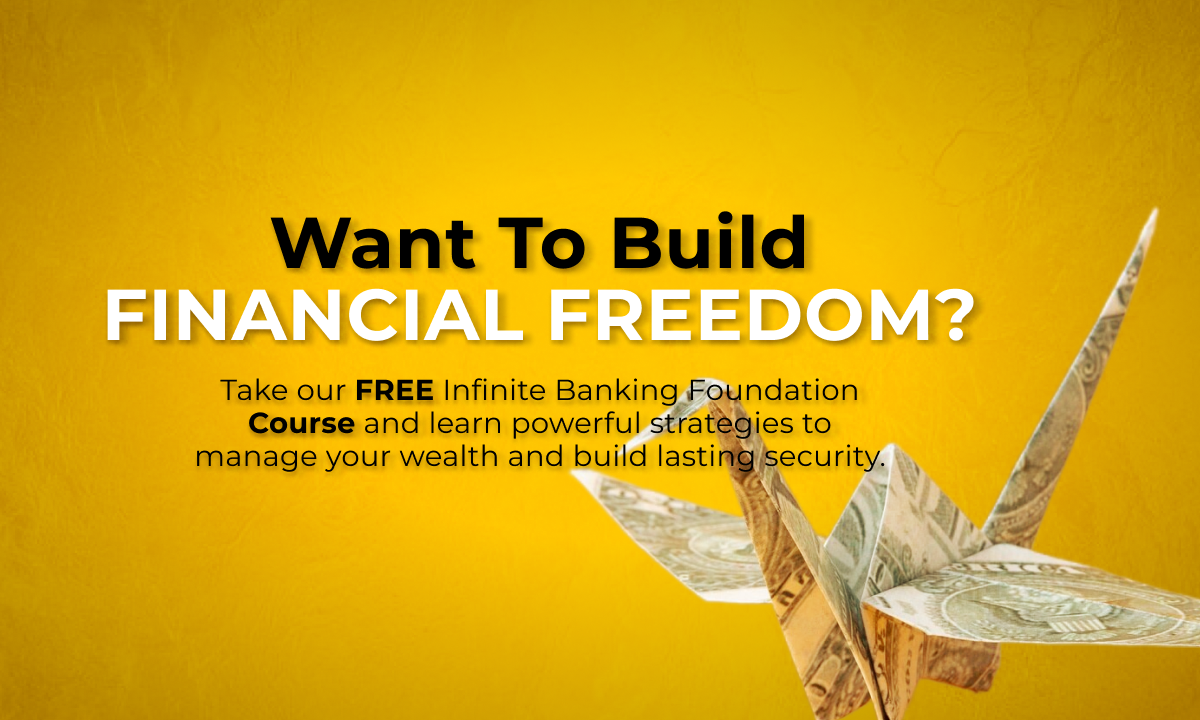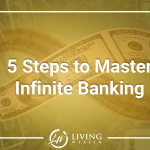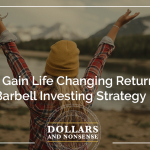Does your faith influence your finances?
Most people don’t involve God or their faith when it comes to building a financial strategy.
Find out how to fully unleash your financial potential by making room for God to show up in your life and discovering ways to step out of your comfort zone.
📒Free Infinite Banking Resources 📒
===========================
Want to become your own banker and build a solid financial strategy?
Check out our FREE Infinite Banking Foundations course: https://livingwealth.com/escapethebank
===========================
Subscribe and Listen to the Podcast HERE:📱
➡︎YT: https://www.youtube.com/@thelivingwealth
➡︎Apple: https://podcasts.apple.com/us/podcast/dollars-and-nonsense/id1170598942
➡︎Spotify: https://open.spotify.com/show/5QYt7zArvsPvLYD7OhbXVW?si=8e1021e2dc604f7d
===========================
Nate Scott is an Infinite Banking expert and President of Living Wealth with over a dozen whole life insurance policies that he’s used for the past 12 years to make profitable investments. He created the “Dollars and Nonsense” podcast to explain the ins and outs of Infinite Banking, helping you take control of your finances and achieve true financial freedom.
===========================
Let’s Connect!
Website: https://livingwealth.com/
LinkedIn: linkedin.com/company/living-wealth-
Instagram: instagram.com/itslivingwealth
FaceBook: facebook.com/livingwealthco
Twitter: https://x.com/thelivingwealth
————————————————————————————————

LIVING WEALTH PODCAST
DOLLARS AND NONSENSE: EPISODE 242 TRANSCRIPTION
[00:00] Nate Scott:
The number one skill you need to become successful financially is to learn how to measure the risk reward ratio for any investment opportunity that comes across your desk. The most effective approach for me is to use what I call the risk reward quadrant when evaluating financial opportunities. I’m Nate, I make sense out of money. This is Dollars and Nonsense. If you follow the herd, you will be slaughtered.
What’s been a total game changer for me, and it helps simplify my life completely is whenever I decided to start weighing the risk-reward opportunities that were in front of me by using what I call the risk-reward quadrant. So I created this as a way for my own personal life to determine where am I going to put certain investment opportunities into this risk reward quadrant, really.
And how this simplifies things is I think most people are asking me, Nate, how do you find investments? Where do you find investments? I think for you, you need to understand like the skillset that you really need to be able to understand where you should put money, I think is based on where you think you should be putting money on this quadrant.
Risk Reward Quadrant
[01:09] Nate Scott:
What is missing in your life? And if you’ve heard me in the past, I’ve talked about what’s called barbell investments. I actually learned that concept from reading the book Antifragile, where he talks about investing on the barbell. And more recently, Tony Robbins came out with a book called The Holy Grail of Investing.
And in that, he talks about this same exact thing that Antifragile discusses that all the big money players in the world utilize to judge financial opportunities. And the idea of the barbell is that, you only weigh two ends of the spectrum, right? So that, I mean, that’s why the barbell is a good picture.
You have a weight on the far opposite extremes and it’s a way to create a life that has a huge amount of upside potential with very low downside risk overall. And that’s why the guy who wrote the book Antifragile, Taleb, why he says that it’s truly a way to build your life, avoiding fragility and a way to get into an antifragile life is if you stop living your life in the middle where you can make money, you could lose money, you don’t really know much about it.
[02:14] Nate Scott:
Whereas if you just focus on either extreme, the safe, conservative, focused side of the barbell, that’s on one side. And then the other side is not actually the high risk flashy gambling that goes on. He actually describes that at the far end of the barbell is actually the asymmetrical opportunities where the upside potential is extremely high for the amount of risk that you’re about to take.
And so I believe that evaluating risk is the single most fundamental skill you can learn to become successful with money. And that’s why I believe the risk reward quadrant that I’m going to dive into today is going to be extremely beneficial. So I am going to put a screen share up on the YouTube video for this, but if you’re listening to the audio, you’ll get everything out of it too.
Low Risk-Low Reward Quadrant
[03:04] Nate Scott:
So essentially a quadrant is going to have four squares, right? And you’ll see that on the screen here. And we have two directions that we can go, we can have low risk, low reward, that would be kind of on the bottom box. We have low risk, high reward. We have low reward, high risk.
And then of course we have high risk, high reward. These are the four quadrants that we’re going to define today. So we have the low risk, high reward. All right, let’s start with the low risk, low reward quadrant, which I’m going to define right now. So the low risk, low reward quadrant, is, you know, of course, I mean, most of us know what’s going to fit in here.
[03:44] Nate Scott:
So in the low risk, low reward quadrant, this is the conservative piece of your life. And of course, you know what we do at Living Wealth with whole life insurance policies. I believe that whole life policies are actually the king that reigns supreme in the low risk, low reward quadrant. In other words, that you’re not going to get extremely rich by just stuffing money in whole life insurance policies.
But as far as the most competitive, the best solution for that quadrant, I believe, is a whole life insurance policy. But you also have things like treasury bonds, you could throw in here would be low risk, low reward, of course. You know, just regular bond funds in general. You’d have your bank accounts, CD accounts, money, market funds, all of those types of things.
[04:23] Nate Scott:
All of those would exist in the low risk, low reward bucket of your life. And as I mentioned at the very beginning, when you’re talking about barbell investing, you really don’t necessarily want in your life all of your financial energy sitting in the low risk, low reward bucket. You don’t really want that.
I mean, but depending on what stage of life you’re in, it can be more and more important. So the more wealth you build, actually, the more this bucket is going to feel very appealing to you. The more money you have at stake, the more money you would like to live inside of the low risk, low reward bucket.
If you’re just starting out financially, you may be more apt to take risks, you’ve got a lot more time horizon. You don’t have much to lose anyway. But nonetheless, in the low risk, low reward bucket, what I, as I mentioned before, we’re going to expand on this later on, but I believe that really as you’re building wealth, you need to have a decent chunk.
[05:17] Nate Scott:
And we’ll talk about how much as a percentage I think should be in here. In your overall wealth building goals, but in a low risk, low reward quadrant, it’s the safe, secure money that will help you sleep well at night. One of the big issues I think in financial planning as a whole is they kind of downplay this. They downplay the value of this and I’m going to tell you why in just a minute as well.
I’m going to tell you why they downplay it. And I think that they have every right to downplay it when they’re marketing to the masses. But whenever, if you actually want to get active with your money, there’s a reason to really love the lower store word bucket. So we’re going to start there.
Those are your conventional safe places to store money, which I do believe, as I said, I think almost objectively life insurance policies reign supreme because of the tax advantages, the death benefit, the liquidity, all of these things that you could roll in. It’s exactly what you would want. To fit into this bucket. It’s the king of this bucket. If we move on, we’re going to go up to the low reward, high risk bucket.
High Risk Quadrants
[06:20] Nate Scott:
Now the first question that you should ask yourself is what the heck is anybody doing in the low reward, high risk bucket? Why is this even a quadrant? Why do we even have to call this? Why would anybody put money here? The reality is the low reward, high risk quadrant exists whenever you are living in, this is called, I would call it the stupid bucket or to you use maybe a less mean term, this is what I call the ignorance bucket.
Oftentimes in this bucket is where you’re very likely to put money in something just because you got your ears tickled. And it’s whenever I say, I won’t use the word stupid. I’ll erase the word stupid, we’ll just call it the ignorance bucket.
Application and Investment Strategy Development
[07:09] Nate Scott:
In this bucket, oftentimes, you will have a very hard time understanding the risk reward ratio of what’s going on in this thing, so you get sold. This is “the getting sold bucket”. People end up in this bucket all the time. In fact, almost anyone who unexpectedly lost money, putting money into something.
Oftentimes they were sold the value of this thing, but the way that it was sold, it hid the risk and only talked about the reward. And so things were not fully, they weren’t clear, there was not clarity. So they put money in here and they lost it unexpectedly. So I’m going to compare that when we move over to the high risk, high reward bucket just in one second, by the way, oftentimes you may lose money in that bucket, but you understood that there was risk being taken, you might lose money.
[08:02] Nate Scott:
And you were okay with that in the low reward, high risk bucket. Nobody would ever choose to put money there. Nobody would ever choose to put money there. The only time people do is when they are ignorant. They got sold, this could also be called the emotional bucket, they did something that just made them feel good or something like that or they helped somebody out, there was an emotional tie-in.
There was an objective tie-in. So this bucket, of course, you should avoid like the plague. But the only way to avoid this bucket is to no longer be ignorant. I actually just got done with a meeting. I doubt he’s gonna watch this podcast but a client of mine, shoutout to Rob if he’s gonna listen to it, and I just sat down in a meeting with a kind of a guy who’s trying to raise money for his investment opportunity. He is out in the world buying, he’s buying businesses. He’s in acquisition mode and he’s got a cool model. Everything looks great. I think is actually going to be successful.
[08:59] Nate Scott:
But the reason why I would put his opportunity to investors in the low reward, high risk bucket is because he is trying to raise money from investors and he’s describing it as an extremely low risk investment. And he’s pricing the return to investors as if it was low risk. But I don’t believe he’s correct in that.
So essentially this means that the only people who are going to put money in are the people who are going to get sold by the pitch. They’re going to get sold by the pitch. They’re going to buy-in because of an emotional buy-in or they’re just ignorant of how to weigh risk.
So here’s the deal. He wanted to raise money from investors at 10% a loan, a fixed 10% loan. So in other words, there’s no upside available in the deal. The most you can make is 10%. But you are lending your money to essentially a startup business and he’s trying to play it as the startup is just a guarantee to be successful by all.
[10:02] Nate Scott:
Because of all of these measures, we just need capital to get into acquisition mode and he’s not doing it the conventional way. The conventional startup money, venture capital style, private equity style money is in the high risk high reward quadrant. And it’s priced to be in a high risk, high reward quadrant, right?
So in other words, in a high risk, high reward quadrant, which we’re going to go dive into in just a minute. In that quadrant, you’re going to understand that there might be a risk of loss because it’s a startup venture or something like that. However, the ability to make a high return is also is also there.
So they are in balance with each other. The low risk, the low reward high risk quadrant, which we’re talking about right now is when the returns and the risk are not balanced. They don’t offset each other. So you’re actually taking more risk. And that’s the idea. He wanted to essentially raise money as cheaply as he possibly could, hoping that he can convince people of the low risk.
[11:00] Nate Scott:
In other words, he’s offering a return for a small business that would typically be seen as a low risk, medium reward style investment opportunity, but it doesn’t fit that well. So what me and my client who were getting pitched by this, discussed afterwards is really like, we actually think the opportunity is pretty good.
Like we believe that the business is likely going to be successful, but the risk and the reward are just not tied together. You know, if we put money in and it actually fails and he can’t repay us all the money, we lost money. Was it worth it for a fixed 10 percent with no upside potential?
Now this is different because there’s other times where a 10 percent fixed return could very well be a decent, low risk, relatively high reward scenario. It all depends on if you have collateral, if there’s things backing it up, in other words, the actual return itself is not what’s at play here.
[12:00] Nate Scott:
It’s the fact that the deal he was trying to get money as cheap as he possibly could So he could keep as much of the upside potential for himself, offer as little as possible to investors and essentially try to convince us that the reason why that’s acceptable is because the risk is just so low. It’s almost a shoe-in and what we say, that’s not correct.
So the only, so we’re going, we would come back to him and say the only way we would be able to invest money is maybe something like a preferred share style investment. We’ll invest money as preferred shareholders with a 10% coupon or a 10% preferred dividend, plus an equity buy-in, you know, that’s what he should be doing.
[12:41] Nate Scott:
By the way, he should be offering some sort of equity buy-in, some sort of upside potential above the 10% in order for investors to sort of start piling in. So here’s what I’m trying to bring up. The pitch is good. The business sounds good. People are probably going to put money into it and maybe it’s going to work out.
But the truth is it’s those types of deals that go south, that you lose money and you didn’t expect it. And every time that occurs, you have some sort of ignorance. You did not understand the true risk. You got sold something. It was an emotional buy in. You should never have gotten involved at all. So the low reward, high risk quadrant needs to be abandoned by everybody.
The only way to do that is to step out of ignorance truly and start to learn this. So I would weigh that as saying, hey, If there is a risk of losing money, the reward has to price that in. He is essentially pricing it as almost zero risk of losing money. That’s not true. So we can’t get involved at that price.
[13:47] Nate Scott:
Some other people may come in and say, 10% sounds good. Well, 10% sounds good depending on what? What factors? Remember, the rate of return is a worthless metric because unless it prices risk, you have to learn how to put things in this box. So I would say his pitch was a low reward, high risk pitch.
So what am I going to do? Say no. I’m going to say no. It’s not a low risk, low reward. It’s not a high risk, high reward. And then it’s not a low risk, high reward, which by the way, is going to be the Holy grail. The low risk, high reward is what we’re going to talk about in just a moment. So let’s move on to the high risk, high reward.
And of course this one is also very commonly known. So the two, by the way, the two quadrants that everyone really understands are the low risk, low reward quadrant. That’s like, you know, the safe money. Low risk, low reward, whole life policies, treasury bonds, all that. And then the high risk, high reward.
[14:35] Nate Scott:
We also kind of understand what that is. That would be like startup ventures, right? Startup investing in companies. This is like venture, startup venture capital, something like that would be involved here. You could put cryptocurrency in here, you know, as a high risk, high reward, day training would be in here where you know, there’s a potential for high risk or constant, you can even call this concentrated investing as opposed to diversified investing is when you buy one stock because you think it’s going to go up, but there’s high risk, high reward there.
In this quadrant, the high risk, high reward quadrant, it’s a fun quadrant. It’s an exciting quadrant. Of course, when you enter into this quadrant, you know that there’s a decent chance that this might not happen. That’s why it’s all in venture capital. So whenever you’re in this quadrant, you really just don’t want very much. We’re going to talk about how to weigh, by the way, what should be involved.
By the way, I’ll go ahead and put a 0% in the low reward high risk quadrant we talked about. I’ll go and give that bag away. We want 0% of our money in that quadrant. Please run away from that quadrant. Some of you, I think, probably have money in that quadrant and it’s because you haven’t–
[15:43] Nate Scott:
Most people who put money in the closet haven’t fully discovered how to weigh the risk reward ratios and create barbell opportunities, asymmetrical opportunities, which is really what you want.
So in the high risk, high reward quadrant, you don’t want a ton of your money in there, but it is fun to dabble in. So I definitely have some money in the higher risk, higher reward quadrant. It’s not something I love to do, but it’s kind of fun to dabble in.
This is a true, by the way, this is a true gamble. A lot of times it can be an educated gamble. It’s a bet. We could say, we’re like, based on what we know, an educated bet. It’s like playing poker. Like, I think my hand is going to win here, so I’m going to go all in. You, someone else might have a better hand.
[16:54] Nate Scott:
The economy might collapse. Russia might send a nuke to Ukraine and the economy collapses and this bet that you’ve made the other guys got a straight flush or something like that, it’s going to be just totally out of the blue. You didn’t think it was going to happen.
So this can be an educated gamble. That’s where you’d want to involve with this. I would say at most maybe 10 percent of your net of your assets could be involved in high risk, high reward situations. And so it’s just good to know that you’re understanding.
Like in other words, it’s not like I would say don’t put money here but you need to know that if you’re putting money into the high risk, high reward quadrant, you need to know it shouldn’t be an excessive amount of your total net worth. It’s an educated bet, educated gamble. Don’t go all in on this for sure.
[17:35] Nate Scott:
And in the last quadrant the holy grail of investing is the low risk high reward quadrant. So obviously, the low reward, high risk and the low risk, high reward quadrants are on the opposite end of the spectrum, and that’s where all of the confusion lies.
So at the low reward, high risk that we just talked about, where there’s not much upside and there’s a lot more risk than you thought, what you would ask, why would anybody put money there? And what I would say is people lose money in that quadrant all the time. All the time. They unexpectedly lose money.
By the way, in high risk, high reward, people lose money in that quadrant too, but they expected that that was possible and they were okay with that. And the low reward, high risk, the only reason anyone would ever put money in there is if they didn’t expect to lose money. And then it’s lost and they realize, oh, we made a value judgment incorrectly.
[18:28] Nate Scott:
We weren’t expecting that, it wasn’t priced incorrectly. So people are confused about that quadrant. They’re also confused, they would come to me and say, Nate, of course everybody’s going to want to put money in the low risk, high reward quadrant, that’s the unicorn. I mean, that’s where everybody wants to be in the low risk, high reward quadrant.
Nate, where do you find these deals? And I’m just having fun with that. But what I’m trying to say is, yeah, this exists all the time. The one word answer for the low risk, high reward quadrant is called strategy.
[19:02] Nate Scott:
If you looked at the low reward, high risk, if the one word answer for that one was ignorance. The one word answer for the low risk, high reward is strategy. There’s a big difference between a passive real estate investor who gets sold on turnkey opportunities and all of these other things where they don’t quite, they haven’t actually developed a strategy that they can implement.
So this would be you know, just a guy who’s just oh I hear real estate’s a good thing to get into sometimes, let me go just buy whatever property comes out in the market within my price range with no strategy.
[19:38] Nate Scott:
That of course would be, you’re taking way more risk versus the guy who says, who learns about real estate investing, takes courses, becomes a good investor, you know, researches the market, puts in work and then realize, okay, now I know how to find deals that are likely not going to lose money and are likely going to make me a decent amount of money.
And that exists. So in the world of low risk, high reward, oftentimes you have your own business. So if you are in business, if you’re an entrepreneur, reinvesting money into your business, oftentimes is one of the best ways to create asymmetrical opportunities.
So in this one, it’s always asymmetrical opportunities inside of a low risk, high reward, inside that would be the term people would use in the money world. Asymmetrical opportunities, which means that the chance of loss is actually relatively low compared to the high upside. And I know everyone’s saying, Nate, where do you find these? These are oftentimes created, not sold.
[20:36] Nate Scott:
So a lot of times whenever you are in this quadrant, you create opportunities, you’re not sold a bag of goods. A lot of times the low reward, high risk, these are sold all day long. These are up there. You’re getting sold on something and that’s why you buy it. The low risk, high reward were oftentimes you have a hand in creating the opportunity.
You understand the game you are in. You have your own personal involvement to some degree. Why we mentioned this all the time is that there’s really no such thing as a good investment or a bad investment. They’re simply good investors or bad investors. And in the low risk, high reward scenario, it actually requires you to become a good investor.
So that you can figure out deals. And so inside of this, inside of the low risk, high rewards, and you’re like, what types of things are typically involved in there? Those are types of things where your money is actually solving a problem that’s priced fairly. So in this, it would be like some sort of, in this world, it would be, where, I mean, in my own life, right?
[21:46] Nate Scott:
You have a network of people that are doing things. They’re in business together. They’re starting new businesses, they’re raising money and they’re negotiating with you how to get involved, where you have an ability to create, to understand the risk and understand how to create a reward that can be a win-win scenario.
So I’m gonna make one more note. I’m running out of this, but oftentimes you’ll see win win scenarios exist inside of the low risk, high reward. So then you’re going to put an investment. If it’s going to be in something that somebody else owns, like another buddy, somebody’s business, oftentimes it’s going to be a win-win scenario and they’re like, they need capital.
They can’t raise it from the cheap sources, but there’s a reason why through understanding that it’s really pretty low risk overall, but maybe the conventional financial sources don’t want to get involved in their business for whatever reason, or maybe it’s also they just are tired of dealing with banks.
[22:41] Nate Scott:
And so you are kind of coming in to solve a problem with a win-win scenario that you say, yeah, I mean, I’d be happy to do it. Of course, I’m not going to give you bank-style returns, like 7 to 10%. I’m not going to do that for this risk class, but I’m helping you solve a problem.
And because you’re helping them solve a problem, they are willing to offer higher rewards for the risk class because they’re like, yeah, it’s not just Nate investing money, it’s Nate helping me solve a problem. This can also be with starting a business that’s likely to succeed where you can kind of weigh the chances of success.
Most businesses that you are actually involved in where it’s not like some sort of technology startup, like that would be the high risk, high reward thing where it’s more of a gamble, it’s more of a bet. You’re betting that they’re good and that it’s going to take off into the future.
[23:33] Nate Scott:
And so you’re getting in on the ground floor. It may or may not work out. If it does, awesome. So those are the high risk, high reward and the low risk, high reward. That’s like actually starting a business where you have some involvement in it. You have some guiding force involved in that new business.
So, you understand the risk very, very well. And that is really where most barbell opportunities exist. They’re created, they’re manufactured by what you know how to do. So you’ll talk to people who are, you know, I know I have clients that are really big into, what are storage facilities, right?
They’re really big in the storage facilities. They have gotten, they have a know how now on what makes a good storage facility. So every time they open a new storage facility, it is a low risk, high reward endeavor. Is it low risk, high reward? The idea is this is storage facility investing low risk, high reward for everybody.
[24:27] Nate Scott:
You would say, no, it’s not. It can actually be low reward, high risk for the ignorant person, but for somebody who is actually successful and is strategic and understands. They have created an investment that could go south for somebody else as a way to really be like, hey, it’s very low risk. We have the formula.
That’s why your own business is oftentimes the best place to develop a low risk, high reward strategy. So now that we’ve kind of laid this out, what I really believe is if we start to plan this out in our own life, you also know this really quick, by the way, one thing was missing. One thing was missing from this whole concept.
And that is, well, Nick, where do you fit in? Like your diversified brokerage account, like in the S&P 500 ETF and you know, your 401k mutual funds, all of these things, I would kind of put them right in the middle. I would, I’m just going to put like, let’s say mutual funds right in the middle of this quadrant.
[25:25] Nate Scott:
And what that means is like, they’re not any of these. They’re not low risk, low reward. They’re not low reward, high risk. They’re not high risk, high reward. They’re not low risk, high reward. They are this, they’re kind of a unique blend. They’re just a built in diversification tool that typically involves a piece of all four of these wrapped up into one thing.
And this is why you’re going to get average returns inside of just focusing on, you know, your typical S&P 500 ETF, you’re just going to get a bunch of all of these. There’s going to be some higher risk, high reward, low risk, high reward, low risk, low reward. You’re just going to get a conglomerate of all of it built into one.
And there’s a place for this, and so I call that the mass marketed group. I actually do believe that for a lot of society, who doesn’t really want to be hands on with their money–
This, by the way, so here’s my final answer like this quadrant exists for those who are wanting to put their money to work themselves and actually make some, they need to understand how to weigh these risks and put things in different quadrants. If all you’re wanting to do is passively stuff money aside, you could probably put, you know, 70% of your overall , net worth into mutual funds, retirement programs, and just let it sit there and maybe have 30% in the low risk, low reward, things like whole life policies, you know, bank accounts, you know, offsetting, different risk class.
[26:52] Nate Scott:
And you don’t have to mess around with trying to get your hands on money because you don’t, because honestly, if you did and you didn’t have any strategy or you were just ignorant about things, you’ll probably wind up throwing money into the low reward, high risk quadrant that we already told you, please run away from.
So what I’m saying is to the masses that middle ground thing that a mutual fund’s whole goal, by the way, is to just conglomerate all four of these quadrants, put them into one deal, sell it to the masses, for those who don’t want to deal with money. Great! What we are talking about here at Living Wealth is more focused on saying, hey, this is for people who don’t really want that life.
Who don’t really want the life of, we don’t really want the life of, of just simply being very passive. So inside that middle box, it doesn’t really fit in any quadrant. It’s kind of a collaboration of all quadrants. What I believe though, if you want to create not average results, but above average results, extraordinary results financially, then the only two boxes that you should really focus your time and attention on are going to be the low reward, low risk, low reward bucket and the low risk high reward bucket, of course.
[28:00] Nate Scott:
And that is the fundamental barbell investing style scenario where you are investing on either end of the spectrum where your actual chance, like Warren Buffett says of losing money, like rule number one of investing is don’t lose money. Rule number two is don’t forget about rule number one. That is the reality in the low risk, low reward bucket and the low risk, high reward bucket.
If you focused your attention on both of these, so you have all of, let’s say you’re doing infinite banking like me, then I have the vast majority of my liquid capital sitting in my whole life policies growing by 4 to 5% tax free with no risk. And completely liquid and available for me to use anytime.
So I have a big chunk of my capital sitting in these policies and I use those policies to fund these low risk, high reward strategic opportunities and you don’t need that many. That’s what I keep communicating to people. You don’t need that many of these opportunities to be wildly successful financially.
[29:02] Nate Scott:
That’s the whole idea of the barbell investing. We’re going to skip over a lot of, we’re going to skip completely the low reward, high risk bucket. We’re not going to put any money there. No one should ever put money in there. We’re going to skip over the mutual fund middle ground, really, for very much of our world and we’re not going to stuff all of our hopes and dreams on the next AI or crypto ventures as you know, betting on those going all in in order to be successful financially.
We’re gonna do it more like Warren Buffett style. We’re gonna not take risks. We’re not gonna lose money. We’re gonna continue to go up and we’re gonna take advantage of very specific opportunities. So the way I think about it is typically I would want in my own personal life about 40% of my assets at any time to really be sitting on this end of the barbell and the low, the low risk, low reward and my whole life policies, right?
I want a big chunk of my “net worth” sitting in this bucket. And then I will also probably put about 40% into the low risk high reward bucket. So those are the investments that I really take advantage of. So you have the vast bulk of your money is going to be centered on the barbell strategy.
[30:13] Nate Scott:
I’m going to completely, of course, ignore the low reward, high risk bucket, and I will probably put about 10% of my investments into the high risk, high reward bucket, things like crypto or startup ventures or things that are more of a bet where I don’t really have much control over the outcome, but it was kind of, it was fun to get involved when I’ll buy some and see what happens.
And then I don’t mind if people want to put maybe about 10% more into that middle ground. You know, mutual funds style. So essentially you could do 10 to 20% in mutual funds, S&P, whatever it is, and 10 to 20% in the high risk, high reward. And you can kind of move those around whichever way you want.
But those are things that kind of fit in the middle of the barbell. Like you could lose a lot of money. You can make some money. You might make a ton of money, but it’s not going to fit our, our, our true antifragile-focused life. So as I said, at the very beginning, I do believe. that when you understand how to weigh the risk reward ratio for the opportunities, and I think partly you could, you could ask, you could put them on this quadrant yourself.
[31:15] Nate Scott:
Like when investment comes, where am I going to put this? And then you can then say, okay, I think this is going to be a low reward, high risk opportunity after weighing all of this out. And so you can immediately trash it. Or you could renegotiate to see if you can move it into the lower risk, higher reward category, by weighing the risk correctly.
But essentially the idea is this, you can then, once you’ve decided where an investment would fit, you then determine, hey, do I want to continue dumping money into those? The honest truth is when I say 40% into the low risk, low reward, low risk, high reward quadrants at the end of the day, you could put a ton, you could put more in either one at any given moment in time, but this is just kind of a lifetime average.
Or sometimes you’ll have a lot more sitting around waiting for opportunities. Sometimes you’ll have a lot more invested into the lowest car reward. But no matter what we’re saying, 80% should be in those two. I guess that’s what I’m trying to say. 80% should be in the low risk reward and the lowest high reward creating a barbell antifragile life.
[32:12] Nate Scott:
We’re very low risk of losing a ton of money, very high risk of continuing to get wealthier every single year, sometimes dramatically and then have a little bit of money in more conventional things or high risk, high reward things. And I think you’ll really enjoy your life. This is not for the masses.
But this is truly a way that you can create a life that you won’t want to retire from. You could continue playing this game of money for as long as you possibly can. It’s been so fun to have you guys on the show as always. I would say too, if you want to understand more about why whole life insurance policies are the best low risk, low reward quadrant opportunity.
[32:48] Nate Scott:
And you want to learn more about what we do called infinite banking and how it uses these policies to finance investments and things of life. Become your own banker truly. You can go to our website, https://livingwealth.com/ and you can sign up for the Free Infinite Banking Foundations course, or just book a consultation with our team.
And we’d love to chat with you for free and just describe exactly– It’s really just to see if this is a fit for you, it’ll be fun to do. So guys, this has been Dollars and Nonsense. If you follow the herd, you will be slaughtered.










